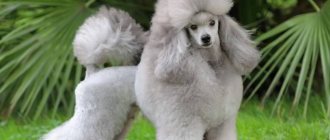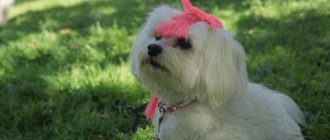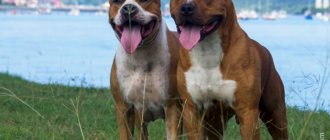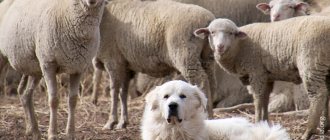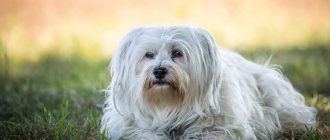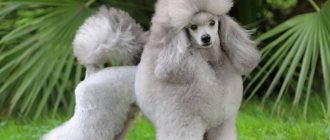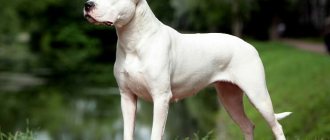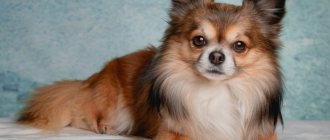Great Dane in the photo
Everyone knows that man's best friend is a dog. The Great Dane is proof of this saying: loyal, kind, strong, level-headed and courageous. There are 6 types of Great Danes, all of them come from different countries, and therefore are endowed with an original appearance and unique working qualities.
History of the origin of the species
The breeding of breeds under the general name “Dog” began in the early Middle Ages. The ancestors are considered to be mastiffs born in the Tibetan mountains, distinguished by their large size, strong character, and fearlessness. They were domesticated by pastoral tribes. Subsequently, two large groups were formed: Great Danes and Asian Shepherds.
During migration, dogs showed themselves to be reliable human companions, capable of protecting themselves and others, and always being there. They were especially valued during the development of Mesopotamian civilization. They participated in the battles of the Greek army and Roman civilization.
Once in Europe, the genes of bulldogs and wild boar dogs were added to the blood. Initially, all strong, strong, hardy dogs were called this, and later a division into breeds appeared. Since ancient times, the Great Dane has been used:
- as a participant in battles, including gladiator battles;
- as an assistant for hunting animals;
- in the role of guard of territory and housing.
The Great Dane is considered to be the direct ancestor of the Great Dane. In modern times, this is a companion dog that is always next to its owner.
What to feed
Keeping Great Danes at home involves not only general dog care, but also nutritional care.
Almost all mastiffs have a tendency to obesity. Most often this is due to insufficient activity and poor diet.
Great Danes are recommended dry food for large or giant dog breeds, super premium or holistic class.
You can also add minerals and vitamins to your food to support overall health.
Features of Great Danes
To describe breeds from the “Mastiff” group and include new species, it is necessary to focus on common features. They are characterized by the following facts.
- Exterior. Outwardly she looks massive and tall. The muscles are clearly defined. The limbs are long and strong. In some representatives the height at the withers reaches 110 cm at the withers. The weight is large, which is explained by muscle mass and the length of the body.
- Anatomical structure. Due to the location of the shoulder blades relative to the chest, which affects the special position of the front legs. Therefore, the elbows are in free movement, which is convenient when running and jumping.
- Torso. The chest is large, and in most breeds the belly is tucked up. The large volume of the lungs allows you to overcome distances and obstacles without problems.
- Tail. Located high, slightly curved, long.
- Head. Massive, distinguished by a clear transition of the nose to the forehead. Square jaws are framed by slightly drooping lips. The grip is strong. Most Great Danes are characterized by dark masks on their muzzles.
- Leather, wool. Numerous skin folds protect the dog from wounds. The coat is short, smooth, and lies tightly. The color is different, depending on the breed: from snow-white with spots to blue-black.
- Health. From Mollos, Great Danes inherited the vulnerability of the structure of the musculoskeletal system. They are prone to early arthritis and arthrosis. Without exercise, problems with obesity, gastrointestinal tract, and diabetes appear. Weakness of cardiovascular activity is explained by its specifically powerful structure. Not all dogs can withstand increased stress.
All are characterized by a calm, somewhat phlegmatic behavior. In case of danger they react immediately. Capable of being the first to engage in battle and show aggression. In everyday life they seem slow.
A genetically fearless dog whose purpose is to protect the territory, home and owner.
Distinctive features
The Great Dane has the following exterior characteristics:
- The head is large and long.
- The ears are pointed, slightly erect at the point of placement on the skull, the main part is hanging; sometimes they stop at will and can be erect.
- The forehead is flattened, high, wide.
- Cheekbones with pronounced muscles.
- The stop is pronounced; muzzle and skull are of equal length.
- The muzzle is rectangular in shape, voluminous.
- The jaws are powerful and wide.
- bite .
- The teeth are white, large, 42 in number; incisors do not protrude beyond the bite line.
- The eyes are medium-sized, almond-shaped; the setting is not wide; dark, merle-colored mastiffs can have light ones, and heterochromic ones are also found.
- The eyelids are dense.
- The nose is large, pronounced; black lobe.
- The nostrils are massive and open.
- The lips are tightly compressed and black; Great Danes of merle color may have light colors; The upper lip hangs down at an obtuse angle.
- The croup is powerful, with pronounced muscles, shortened.
- The neck is high, with a slight slope forward, strong, muscular, proportional.
- The withers are clearly defined and graceful.
- The back is short, the loin does not stand out, the line is straight.
- The chest is rectangular in shape with slightly rounded edges, deep, wide.
- The abdomen is slightly tucked.
- The shoulder blades are long and sloping.
- Forearms and wrists are straight, parallel, and muscular.
- The hind limbs are very strong, elastic, powerful.
- The shin is long.
- Paws are round in shape; fingers tightly adjacent to each other.
- The claws are short.
- The movements are smooth, slightly springy.
- The skin is elastic, pigmented.
- The coat is short, dense, there is no undercoat.
- The color is straw, brindle (black stripes on a background of red shades); black, marbled (white or gray base with black markings); blue.
- The tail is in the form of a saber, has a visible thickening at the croup, the seat is high, reaches the hock joint, in its natural state it is lowered, there is no hair.
Varieties of Great Dane breeds
American Great Dane
A fearless breed with a height of up to 68 cm at the withers in males, weighing up to 55 kg. Sexual dimorphism is pronounced. It is considered an unpretentious dog to care for and train, which is peaceful towards others. It is characterized by the structure of its muzzle with a slightly upturned nose and hanging V-shaped ears.
Dogo Argentino
Used for official and search purposes. The character is complex, prone to aggression. Stubbornness is noted and requires proper socialization. The body is slightly elongated, the stomach is tucked. With a height of 60-68 cm, the dog weighs 40-45 kg. The chest is developed. The muzzle is framed by jowls. The grip is very strong. The wool is white. Small spots possible.
Great Dane
The dog is recognized as “royal” due to its specifically arrogant behavior, ability to control emotions, and regularity. Beige coat color. The breed is characterized by a black mask, darker shades on the ears, which droop and lie close to the skull. Numerous folds on the muzzle make the appearance thoughtful and philosophical. Looks like a picture from a cartoon or TV series.
Dogo Canario or Cane Corso
The breed was obtained by hybrid crossing mastiffs, the indigenous dog Mahorero and bulldogs. Originally used as a herding dog for working with cattle. According to the standard, height should not exceed 66 cm in males. A powerful dog of typical brindle color with a black mask. The skin hangs down around the neck and forms folds on the forehead. The dog is not prone to breakdowns or excessive emotionality. An excellent companion guard with excellent physical qualities (strength, agility, agility).
Dogo Brasil
More often it is called “Filo Brasileiro”, which is characterized by the following features: massiveness, many skin folds, and a mask on the head. According to the standards, all colors are acceptable. A selective breed obtained by crossing a mastiff, an English bulldog and a bloodhound. Hence, the behavior of a tracker and hunter is observed. The “British” inherited regularity, patience, and equanimity. The breed is prohibited for breeding in several countries.
German dog
Those who see the dog for the first time are struck by its tall stature, aristocratic appearance, calm disposition and seeming complete carelessness. This is an elite breed. Initially it was planned to be used for hunting. It is considered a companion dog that accompanies human life. The shape of the body is closer to a square. Pronounced muscles are emphasized by shiny coat. A variety of colors allows you to choose the one you like best.
Tibetan mastiff
More often the breed is referred to as a mastiff. It has a thick coat with an undercoat, which allows it to withstand any weather conditions. The weight of an adult male varies from 60 to 70 kg. with a height of over 70 cm. It looks fascinatingly powerful. A strong, brave dog, ready to enter into an unequal battle with a wild beast. He is capable of making independent decisions, so he should be brought up in strictness.
Cuban Dogo
It is believed to be an extinct dog that originated on Liberty Island. The result of crossing an Old English Bulldog and a Spanish Mastiff. Used as an aid in the search for Indians escaping slavery in Florida. A few representatives have survived.
Alanian Great Dane
The fighting native breed from the group of ancestors of the Molossoids is not recognized internationally. It was a hunting dog for driving and baiting wild animals. Due to land reductions, it began to gradually disappear. The restoration of the breed began only in the 80s. last century. An assistant dog, a bodyguard, a security guard has a special status. It is emphasized by a dry, lean body, an elongated neck, and large limbs. The muzzle is brachycephalic, square, with a pronounced stop. The color is brindle, the coat is hard and dense to the touch. The character is complex, shows intolerance to noise, and does not perceive strangers well.
Muscovy dog
An almost extinct breed, bred in the Soviet service dog kennel “Red Star”. It was obtained by crossing a Great Dane with an East European Shepherd. Constitutional features are strong and hardy. The muscles stand out sharply in the area of the shoulder-scapular joints, hip muscles, and are emphasized by short hair. The head is wedge-shaped, the forehead is sloping. A service dog is characterized by obedience and attentiveness.
French Dogue
The Dogue de Bordeaux or French Mastiff gained popularity after the release of the film Turner and Hooch. Massiveness is a characteristic feature of the breed. The body is covered with thick skin that forms folds. The short coat lies close and is smooth, almost silky to the touch. The standard color is red, without a mask on the face. The overall impression is threatening. For the owners, this is a calm, reasonable dog.
Russian Great Dane
Selection work of the Soviet nursery. In order to obtain a new breed, a combination of different representatives from the groups of Molossians, Shepherd Dogs, Mountain Dogs, Schnauzers and Terriers was used. The task was set to obtain a new working dog that would perform guard and security functions with moderate anger and be resistant to weather conditions. For the standard, a height mark of 65 cm with a weight of 57 kg was chosen. The coat is black with tan, the eyes are brown, the muzzle is similar to a hybrid of a shepherd and a Rottweiler. The body is slightly elongated on strong legs, with a reinforced sternum.
Miniature Great Dane
A cross between a bull terrier and a bulldog, bred in the USA, is not popular in the world. The sizes are small. The height at the withers is only 15 cm. The weight should not exceed 10 kg. A convenient dog to keep in the house due to its miniature size. Terrier genes make the character active, cheerful, and curious. The dog is not difficult to train.
Dogo Neapolitan
A specific representative of Italian dogs. His body is covered with a huge number of numerous skin folds. They protected dogs during dog and gladiator fights. Relatively squat in appearance, the body is elongated. The color is dark silver. The jaws are framed by jowls. The view seems scary. He is a good-natured helper who is dependent on the person. In case of danger, it first warns with a sonorous bass voice.
Great Dane
A medium-sized dog of a rare variety, a rarity for Europe. It is called Chongqing. Characterized by courage, aggressiveness, and restless behavior. The color of the pigment is strictly bright brown. Needs strict treatment and early socialization. Selects one master to whom he obeys.
Great Dane
A stocky, endangered breed that was previously used as draft power to carry wounded soldiers from the battlefield, as a territory guard, and as a domestic helper. The fur is red or black. An exact description has not survived.
Japanese Great Dane
A giant breed with the characteristic appearance of a mastiff. Weight can be from 40 to 90 kg, there are no strict criteria. An adult dog has fearlessness, power, and the ability to attack on command. Knocks you down immediately due to body weight. Strongly standing limbs make it stable, so the dog is compared to a sumatori athlete. It is difficult to bring up under conditions of attentive attention.
Pakistani Great Dane
The progenitor is the Dogo Argentino. It is distinguished by its courage, natural grip, snow-white coat with spots and splashes. The weight and height of an adult dog is 100 kg. A dangerous breed for which there are no barriers. Attacks without warning, knocks you down, strangles you. Needs a strict owner.
Staffordshire Great Dane
The fighting dog is the result of crossing bulldogs with terriers. The character is complex, tough with notes of aggressiveness, poor breeding. Strong bones, muscularity with medium size, and fearlessness make him a dog that falls without warning and has a death grip. Does not tolerate competitors, does not get along well with children and other pets.
South African Great Dane
The Boerboel is intended for hunting, guarding, protection, requiring a special canine approach. Remains unrecognized by most cynological unions. The dog is easily provoked into aggression; he is considered disobedient, stubborn, and arrogant. Due to the specific structure of the body and paws, it already develops powerful speed at the start. Valued by large game hunters. Genetically, the breed remains an uncontrollable teenager for a long time. Until the 90s it was considered endangered. Over the past decades, there have been more and more lovers of brave dogs.
Bernese dog
The ancestor of the Tibetan Great Dane breed, from which they inherited beautiful, long, thick hair. The color is a specific tricolor in a combination of white, black and brown. One of the most good-natured representatives of the group. Knows how to care, protect, and faithfully serve a person. Loves children and pets. Muscularity is hidden under a rich fur coat. Doesn't know how to show aggressive traits. The muzzle, like the head, is square. An excellent companion for those who value canine friendship.
Thai Dane
Bred in the town of Bankev in Thailand. Legend has it that a once short-haired Thai female was crossed with a jackal, which is why the result was such an interesting dog. Spitz-shaped appearance. The behavior is typical for such a group. Ease in jumping, running, carefree, cheerful behavior is combined with a protective character. The tasks of education include curbing irrepressibility, carelessness, and openness. Medium sizes are optimal for keeping in the city with sufficient physical activity.
Dog character
Great Danes are distinguished by their loyalty, calmness, patience and sociability. These are confident dogs that can sometimes be stubborn and uncontrollable. That is why they simply need training and classes with a dog handler.
The breed is suitable for those who are willing to spend a lot of time with their pet and exercise it regularly. Keeping a Great Dane in a small apartment is quite problematic. He needs a lot of free space.
Dogs like the Great Dane require constant exercise to stay in shape. Walking in the fresh air is an essential condition for keeping this breed.
Many dog breeders are not afraid to introduce Great Danes to their children, since they do not show aggression towards them. However, due to their large size, interactions between Great Danes and small children should be kept under close control. As for getting along with other pets, in this case a lot depends on socialization.
To read: Intelligent and original Bull Terrier breed: characteristics, how much does it cost?
The sooner a Great Dane gets to know all the animals in the house, the faster he will make friends with them. It is worth knowing that sometimes dogs of this breed can take a dominant position in relation to other pets.
Reactions to strangers can vary. It depends on the upbringing and degree of socialization of the dog. Dogs of this breed can be wary of passers-by and guests, or they can be completely indifferent.
Those who want to own a Great Dane should know that they are not very clean. One of the features of this breed is profuse salivation .
Features of maintenance and care
A dog that requires a special approach. Simple rules will help you raise a good friend, a reliable assistant:
- First, consider the location of the bed. Most mastiff-type dogs have a coat without undercoat. They are afraid of drafts, dampness, and changes in humidity. A place for a dog to rest is a warm bedding located in a convenient place.
- The size of the Great Dane does not allow it to be kept in a small apartment. For a stately, aristocratic, strong dog, dwellings with a large area and kennels are needed.
- The dog is prone to being overweight and obese. You need long-term exercise, hour-long walks, running, jumping. Availability of free time is another factor.
- It is not advisable to own a Great Dane breed for those who do not have canine experience. By nature, dogs are independent and stubborn. Some of them are prone to aggressive behavior. This must be stopped by the ability to manage behavior.
A varied diet will help you quickly build a healthy body. The dog food industry offers a variety of prepared foods to choose from. Consult your veterinarian about a particular type of food. You can cook it yourself, but you will have to calculate the full supply of vitamins and microelements.
Does not require constant bathing. During shedding, the coat needs to be brushed daily. Folds in the skin need to be treated.
The success of living together is in education
In the modern world, the Royal Dane (also known as the Great Dane) dog has acquired all the qualities necessary for its current survival, but has not lost those thanks to which it gained its historical position.
The main thing about this breed is the ability to get along with almost any normal person. But! If you want to be not a service person, but at least an equal participant in the relationship, be able to prove it to the dog. Let's start with the fact that the Great Dane is a proud animal, so you should beat and scold him only in cases where he is really guilty. Otherwise, the dog may consider you an unfair (read: abnormal) owner and will continue to ignore you as incompetent. A reproachful tone and trust will be more effective, even when the puppy is naughty. At the same time, remember: if you give in and the dog doesn’t recognize you, you won’t get a comfortable existence, there will be a constant quiet war for supremacy.
How to choose the best puppy
The upbringing of the dog depends on how seriously the future owner approaches this issue. The following is required:
- study the characteristics of the breed, its history, examples;
- choose a nursery or breeders offering offspring from good sires for sale; consult with experts about the gender, age of the puppies, and behavioral characteristics.
- Orientation – dog size. A small dog will grow into a huge, healthy, strong dog that will need a lot of exercise.
- A conscientious owner, the seller will boast of titles, awards, and the pedigree of his parents. Cleanliness of lines is an important factor influencing the future of a dog. Upon purchase, a purchase and sale agreement, a veterinary passport, and a puppy card are drawn up.
Is a dog dangerous?
The breed is included in the ranking of the most dangerous and aggressive dogs . If we remember the past of representatives of this breed, then the desire to protect their territory and show dominant qualities is in their blood.
Great Danes were used in hunting to chase prey, they were used to hunt runaway slaves, and they were even kept on the battlefield. The dogs took part in dog fights and were initially known as one of the most aggressive breeds.
However, early socialization, the right approach, constant exercise and training make Great Danes more flexible, restrained and good-natured. The more a dog is surrounded by people, the less it shows its innate instincts of a hunter and warrior. Numerous reviews from owners indicate that Great Danes are completely harmless creatures , sensitive and vulnerable.
Advantages and disadvantages
Among the positive features are the following:
- chic, aristocratic look, emphasized elegance;
- the ability to remain calm in the most difficult moments;
- the opportunity to spend free time outdoors and nature;
- minimal care.
While raising the breed, the owner learns a lot about its characteristics, shares his experience with others, and finds new friends and associates.
The negative aspects are the size of the pet. All mastiffs are distinguished by truly gigantic parameters among dogs. Attentive attitude and canine experience will allow you to raise a true friend.
Price of a dog
The most important question that worries those who dream of owning a Great Dane is the price. It is worth considering that the breed is not cheap. However, on message boards on the Internet, breeders write completely different prices with a fairly large threshold. How much does a Great Dane cost, and what does the price depend on?
- Breeding dogs can be found for around $300 . Puppies at this price will not be purebred.
- The average cost of a purebred Great Dane is about $700.
- If you want a dog of a rare color, born from titled parents, then you will have to pay at least $1,000 .
To read: Giant Tibetan Mastiva dog: character and cost of the dog
The Great Dane is a breed for wealthy and experienced breeders. A dog requires care, competent training and fairly large investments. Still, it's worth it.
Similar breeds
Great Danes are descended from mastiffs. Hence they contain:
- threatening appearance;
- strong backbone;
- physical endurance;
- fearlessness, courage.
Some breeds are similar to the Tibetan mastiff, endowed with rich fur that protects from bad weather. Most have short hair that needs to be combed out. In terms of working qualities, character, and exterior there are similarities with Molossoids.
Mixing with terriers gives the terrier-like Great Dane natural curiosity, courage, and determination. They have hunting instincts, manifested in the ability to catch up with prey, bite, and knock down.
Dietary recommendations
In the first six months of life, frequent meals in small portions are necessary. Then you can smoothly switch to three feedings a day.
Throughout your life, you need to fortify your diet with calcium to minimize the risks associated with fragility of long bones.
In accordance with age, the diet should also change - from an emphasis on fats and slow carbohydrates in childhood, towards protein foods in adulthood. This is necessary so that the growth of muscle mass does not outpace the growth of bones and thereby cause their deformation.
Preference should be given to natural, easy-to-digest foods due to a weak stomach.
Reviews
Polina Semyonovna, 65 years old I have kept dogs all my life, as long as I can remember. In my old age, I wanted a wise, self-confident dog, with whom it would not be scary to live at the dacha, spend the night there, and receive guests. Friends suggested we look at the Great Dane puppies. I arrived and my heart melted as soon as I saw the mother of the dogs. Beautiful, calm, peaceful. Now our Sam is 3 years old. This is our pride. A stranger will definitely not come to the dacha, but the children and grandchildren will have freedom. He is always next to us, wherever we go. Hefty, stately, courageous. I learned everything, all the commands. I adore Samik and am ready to take the same one again. An extra incentive for me to move, take a walk, wander around.
Lyudmila, 32 years old I love Tom Hanks, especially the film with the Dogue de Bordeaux playing his partner, which was released back in 1989. Then I was a teenager and thought: “When I grow up, I will definitely buy myself such a dog.” I dreamed about him. My Hooch is already 6 years old. I'm afraid to imagine what will happen if my pet is gone. They don't live very long. We adopted him as a puppy at 2 months of age. I won't say there weren't problems. It’s good that then a young man appeared who took education into his own hands. He taught Hooch to commands and obedience. There were many acquaintances who fell in love with the “saffron milk cap” at first sight. Despite everything, this is the sweetest, beloved dog with whom there is no sadness. Even if there are problems, he will come, put his huge muzzle on my lap, wink and it becomes easier. It’s good with such a dog, reliable, interesting and funny.
Mating
In addition to the basic rules of mating, common to all large breeds of dogs (first mating after the third heat; upon reaching the age of 22-24 months ; mating of healthy individuals in the territory of a male dog in the morning on an empty stomach), there are special rules in breeding Great Danes.
These rules are established by the National Great Dane Club and relate, first of all, to the prohibition of mating individuals of different colors.
The following combinations of different types of knitting are acceptable:
- black and blue;
- fawn and brindle.
It is not recommended to breed a bitch more than once a year.
Photographer: Monica van der Maden
Briefly about the main thing
- The progenitor of most breeds were mastiffs.
- Among them there are native breeds that have not been subjected to selection, which makes education difficult.
- Some Great Danes are considered endangered representatives of the group due to lack of demand for working qualities.
- They are distinguished by their external calmness, peacefulness, protective qualities, and unique appearance.
- No special care is required, just regular brushing is enough.
- He needs a competent selection of nutrition and education methods. Any manifestation of aggression or intolerance should be stopped immediately.
- The owner must have canine experience.
- A dog that is trusted to protect a home, territory, family. Has a positive attitude towards children and other pets.
- The variety of breeds allows you to choose a powerful, beautiful, stately puppy who will grow into a companion dog.
Interesting Facts
- Jewelry craftsmen from Alexandria have come up with an interesting method of cutting precious stones. An expensive item was wrapped in a large piece of meat and given to the mastiff to eat along with large bones. In the stomach of the animal, the bones were so polished that the jewelers had to do practically nothing else. A slave was assigned to the animal, who was called a “henchman.” He had to extract a valuable element from the droppings. The precious stone, having been in the animal’s stomach, had a special shine and smoothness.
- Great Danes helped Roman fishermen catch bulls. For this, the dog was trained to perform a special trick. The mastiff entered the water not far from the shore and waited for the water to calm down. Then he sharply lowered his muzzle into the depths and, exhaling air, gurgled loudly. The fish floated up from under the stones, and the dog began to jump and hit the water with its powerful paws. Stunned by the blows, the bulls became quick prey for cunning fishermen.
